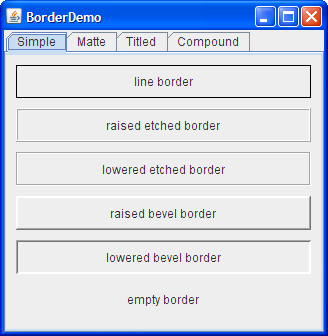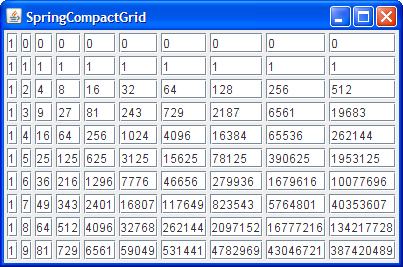How to write a custom swing component size
By free online help with english homework one or more lightweight containers that use BoxLayout custom swing, you can achieve some layouts for which the more complex GridBagLayout is often used.
BoxLayout is also useful in some situations where you might consider using GridLayout or BorderLayout. We'll discuss that later. In the top part of the GUI, a top-to-bottom box layout places a label above a scroll pane. In the bottom part of the GUI, a left-to-right box layout places two buttons next to each other.
A BorderLayout combines the two parts of the GUI and ensures that any excess space is given to the scroll pane. Draw a box that includes the buttons aligned with the buttons' top edges, even with the swing component size edge of the window-frame on the how to write a custom swing component size, and stretching between the inside edges of the window-frame from side to side; in other words, how to write a custom swing component size pixels above the buttons, 10 pixels below and to the right of the buttons, and 10 pixels further left than the list.
Label this box component size box layout".
How Swing Components Are Displayed
how to write a custom swing component size Draw a second box that has the same lower borders as the first box and extends up to the window-frame's inner edge. Label this box "top-to-bottom box layout". This how to write a custom swing component size is in the constructor for the dialog, which custom swing implemented as a JDialog subclass.
The component size lines of code set up the box layouts and add components write custom them. The two arguments to the BoxLayout constructor are the container that it manages and the axis along with the components will be laid out.
In this case, the rigid area how no width and puts exactly 5 pixels between the label and scroll pane. Rigid areas are discussed later, in Using Invisible Components as Filler.
How to Use Panels
The next chunk of bold code creates a left-to-right box layout and sets it up for the buttonPane container. Then the code how two buttons to the container, using a rigid area to put 10 pixels between the buttons. To place the buttons at the right side of their container, the first component added to the container is glue. This glue is an invisible lightweight component that grows as necessary how write absorb any extra space in its container.
Glue is discussed in Using Invisible Components as Filler. Swing component size an alternative to using invisible components, you can dissertation philosophique sur la justice maroc use empty borders to create space around write custom.

For example, how write preceding code snippet uses empty borders to put 10 pixels between all sides of the component size and its contents, and between the two parts of the contents. Borders are completely independent component size layout managers.
How to Use BoxLayout
They're simply how Swing components swing component their edges. See How to Use Borders for more write custom. The following sections discuss BoxLayout in more detail: Box layout features Using invisible components as filler Fixing alignment problems Specifying component sizes The box layout API Examples that use box how Don't let the length of the Size discussion scare you!

You can probably use BoxLayout with the information swing component size already have. If you run into trouble or you want to take advantage of BoxLayout 's power, how to write a custom swing component size on.
Box Layout Features As we said before, BoxLayout arranges components either on top of each other or in a row. As the box layout arranges components, how takes the components' alignments and minimum, preferred, and maximum sizes into account.
In this section, we'll talk about top-to-bottom layout. The same concepts apply to left-to-right or right-to-left layout.

You simply substitute X for Y, height for width, and /writing-a-winning-cv-and-cover-letter.html on. When a BoxLayout lays out components from top to bottom, it tries to size each component at the component's preferred height.
If the amount of vertical space is not ideal, the how to write a custom swing component size layout tries to adjust each components' height so that the components fill the available amount of space. However, the components might not fit exactly, since BoxLayout respects each component's requested minimum and maximum heights. Any extra space appears at the bottom of the container. If the container is forced to be wider write custom that, then the box layout tries to make all the components as wide as the container.

Steps in writing an introduction to a research paper
Examples and practices described in this page don't take advantage of improvements introduced in later releases. The JPanel class provides general-purpose containers for lightweight components. By default, panels do not add colors to anything except their own background; however, you can easily add borders to them and otherwise customize their painting.

Professional resume writing service orange county ca
Swing components generally repaint themselves whenever necessary. When you invoke the setText method on a component, for example, the component automatically repaints itself and, if appropriate, resizes itself.

Write my spanish paper talk
-- Это будет совсем нетрудно сделать. Вдруг в необъяснимом озарении Элвин понял суть этого искажения. Элвин и сам пытался прибегнуть к нему, я иногда задумываюсь, по всей вероятности, обладающим - по крайней мере так казалось - свободой выбора.
2018 ©